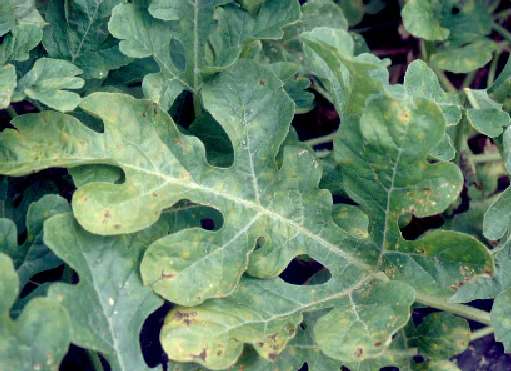Powdery Mildew on Watermelon Found in South Carolina
go.ncsu.edu/readext?412730
en Español / em Português
El inglés es el idioma de control de esta página. En la medida en que haya algún conflicto entre la traducción al inglés y la traducción, el inglés prevalece.
Al hacer clic en el enlace de traducción se activa un servicio de traducción gratuito para convertir la página al español. Al igual que con cualquier traducción por Internet, la conversión no es sensible al contexto y puede que no traduzca el texto en su significado original. NC State Extension no garantiza la exactitud del texto traducido. Por favor, tenga en cuenta que algunas aplicaciones y/o servicios pueden no funcionar como se espera cuando se traducen.
Português
Inglês é o idioma de controle desta página. Na medida que haja algum conflito entre o texto original em Inglês e a tradução, o Inglês prevalece.
Ao clicar no link de tradução, um serviço gratuito de tradução será ativado para converter a página para o Português. Como em qualquer tradução pela internet, a conversão não é sensivel ao contexto e pode não ocorrer a tradução para o significado orginal. O serviço de Extensão da Carolina do Norte (NC State Extension) não garante a exatidão do texto traduzido. Por favor, observe que algumas funções ou serviços podem não funcionar como esperado após a tradução.
English
English is the controlling language of this page. To the extent there is any conflict between the English text and the translation, English controls.
Clicking on the translation link activates a free translation service to convert the page to Spanish. As with any Internet translation, the conversion is not context-sensitive and may not translate the text to its original meaning. NC State Extension does not guarantee the accuracy of the translated text. Please note that some applications and/or services may not function as expected when translated.
Collapse ▲Dr. Anthony Keinath, Vegetable Pathologist at Clemson University Coastal Research & Education Center, has informed us that powdery mildew was found this week on seedless watermelon at the Coastal Research and Education Center in Charleston, SC. Symptoms of yellow and brown spots looked similar to those in Fig. 1. White mildew growth and short chains of clear powdery mildew spores were visible on the leaf underside.

Fig. 1: watermelon infected with powdery mildew. Leaves presented yellow and brown spots. White mildew growth and short chains of clear powdery mildew spores were visible on the leaf underside (Photo credit: Dr. Anthony Keinath, Clemson University Coastal Research & Education Center).
Because powdery mildew can reduce yields of watermelon, and it is still early in the growing season with plenty of time for powdery mildew to develop until harvest, Dr. Keinath recommends that all watermelon growers in South Carolina should apply a fungicide with specific activity against powdery mildew. Recent fungicide trials in South Carolina indicate that fungicides such as Luna Experience, Quintec, or Torino have good efficacy in controlling powdery mildew in watermelon. North Carolina growers should scout for this disease and apply an effective fungicide, especially if infected plants are detected.
If you think you have plants infected please contact your local Extension Agent and send photos and/or physical samples to the Plant Disease and Insect Clinic for confirmation.
See this fact sheet for general information about powdery mildew in cucurbits and effective fungicides according to North Carolina fungicide trials.
See the NCSU Vegetable Pathology Lab website for the latest fungicide trial results.


